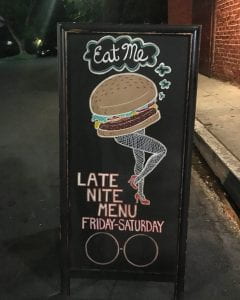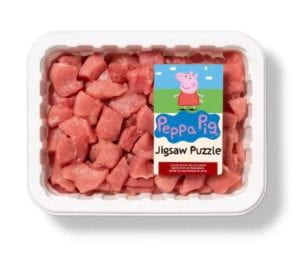The readings on Carol Adams this week gave a more focused look at the sexualization of food and eating in our country, and how the advertising industry frames it. The appearance of women is in so many advertisements that offer food in a way that entices men and sexualizes how we interpret and consume it. Adams mentioned a phrase introduced to her that perfectly describes this phenomenon: anthropornography. She explains it as referring to “the depiction of non-human animals as whores” (Kemmerer 2006), usually “presented as sexually consumable, in a way that upholds the sexual exploitation of women” (Adams, 2009). Much of it shows animals with feminine qualities, or even just parts of women’s bodies, with the rest of their bodies either out of frame, or left out of the image entirely. These advertisements make eating – and it’s usually meat eating – sexy, and imply the promise of manliness and desirability if you eat this meat.
Steak on Offer
The first picture I’d like to analyze is this one below: It features a man standing outside a restaurant which, judging by his apron, he presumably owns or manages. He is proudly standing in front of a sandwich board that boats a ‘cheeky’ (pun somewhat intended) offer to his patrons and seems to be getting some amusement out of it. While selling steak, this establishment decided to put something of a saucy spin on the sale of their steak. The first part of the sign, ‘steak on offer’, implies something illicit and sexual, like one should half expect to find nude women on the counter when walking into the store. This is being offered up, with little to no work on the part of the patron. When combined with the first, the second part of the sign that offers to ‘tenderize your rump’, brings up visions of the aforementioned nude women with red behinds. The way the owner is standing by the sign, it almost looks as if he’s offering to tenderize these steaks for you! But as Adams explains it, these steaks are being offered up, so they want to be violated in this way.

We Deliver
In this image for what looks to be a burger joint, a woman is literally giving birth to a burger. All we see are a woman with her legs spread and a burger between them, which is being received by a doctor. Women are shown, in the picture, to be providing food and carnage to men and other people (as the doctor in the picture is a man, which is a whole other can of worms.) Women are seen as providers and for feeding us when we need it, so of course, it seems natural that a woman would be offering this. But we also can’t fail to to notice the sexual aspect of the woman offering something enticing between her legs. This again shows that minimal work is entailed for the consumer to get this product. Got the urge? We’ll bring it right to you! That’s it!

Eat Me
Another sandwich board offering something saucy! (Hey, another food reference!) Here we have the sexy, tempting legs of a woman, holding up a hamburger. The red high heels and the fishnet stockings signify something a little more overt than simply sexy; it crosses the line into slutty. In her interview with Annie Potts, Carol Adams talks about how these exact images come across in advertising. Female-resembling images are “hanging on the arms of men…chickens in high heels”, but these aren’t always full-bodied women (Adams, 2009). As evidenced in this photo, and some of the others I’ve mentioned, the female depicted character is acting complicit and seemingly “dead and yet she wants it. Wants what? Wants sex; wants to be sexually used; wants to be consumed” (Adams, 2009). What better way to express this than to have a large thought bubble hovering over the burger inviting patrons to “eat me”? The double entendre is seductive enough to get the attention of men who are meat eaters to take notice, and be more intrigued to go inside and order this burger.

Peppa Pig
This final example is a bit more crude than the others, and it is obviously intended as a joke, but can come across in bad taste. Here we see a package of raw pork, chopped up and wrapped, ready to be purchased by the consumer. The sticker that would normally have information about the meat if it were at a grocery store, instead shows a picture and the name of the beloved children’s cartoon character, Peppa Pig; underneath that, the words: jigsaw puzzle. It implied this is a fun game for humans to reassemble our prey before we eat it. Adding a face to the name gives it an extra edge of dark humor that many will find humorous. Again, this picture doesn’t depict anything that is real and out in the world, but it does speak to the way we view and treat animals. It is so commonplace that we oppress and kill these animals that we use the act as a basis for humor and to make light of the topic.

